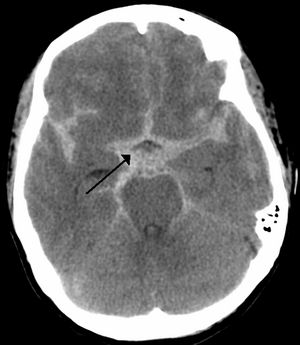Subarachnoid haemorrhage
| Subarachnoid hemorrhage | |
|---|---|
| Synonyms | subarachnoid haemorrhage |
 |
|
| CT scan of the brain showing subarachnoid hemorrhage as a white area in the center and stretching into the sulci to either side (marked by the arrow) | |
| Pronunciation | |
| Classification and external resources | |
| Specialty | Neurosurgery |
| ICD-10 | I60, P10.3, S06.6 |
| ICD-9-CM | 430, 852.0-852.1 |
| OMIM | 105800 |
| DiseasesDB | 12602 |
| MedlinePlus | 000701 |
| eMedicine | med/2883 neuro/357 emerg/559 |
| MeSH | D013345 |
Subarachnoid hemorrhage (SAH) is bleeding into the subarachnoid space — the area between the arachnoid membrane and the pia mater surrounding the brain. Symptoms of SAH include a severe headache with a rapid onset ("thunderclap headache"), vomiting, confusion or a lowered level of consciousness, and sometimes seizures. Neck stiffness or neck pain are also relatively common.
SAH may occur spontaneously, usually from a ruptured cerebral aneurysm, or may result from head injury. In general, the diagnosis can be determined by a CT scan of the head if done within six hours. Occasionally a lumbar puncture is also required. After confirmation of bleeding further tests are usually performed to find problems that may have caused it, such as an aneurysm.
Treatment is by prompt neurosurgery or radiologically guided interventions with medications and other treatments to help prevent recurrence of the bleeding and complications. It can lead to death or severe disability—even when recognized and treated at an early stage. Up to half of all cases of SAH are fatal and 10–15 percent of casualties die before reaching a hospital, and those who survive often have neurological or cognitive impairment.
SAH is a form of stroke and comprises 1–7 percent of all strokes. Surgery for aneurysms was introduced in the 1930s, but since the 1990s many aneurysms are treated by a less invasive procedure called "coiling", which is carried out by instrumentation through large blood vessels.
...
Wikipedia
